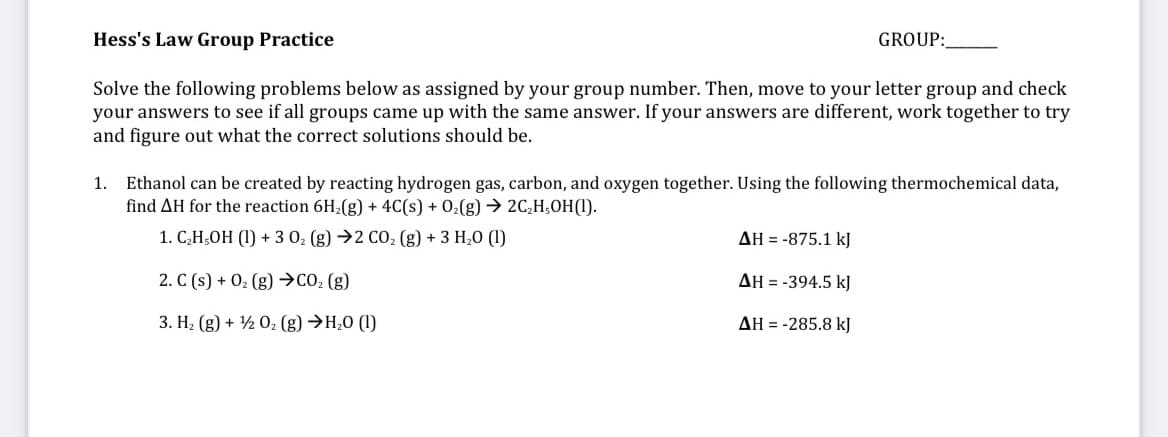Ethanol can be created by reacting hydrogen gas, carbon, and oxygen together. Using the following thermochemical data, find AH for the reaction 6H2(g) + 4C(s) + 0:(g) → 2C,H;OH(1). 1. C,H;OH (1) + 3 0; (g) →2 CO; (g) + 3 H,0 (1) AH = -875.1 kJ 2. C (s) + 0: (g) →cO; (g) AH = -394.5 kJ 3. H; (g) + ½ 0; (g) →H,0 (1) AH = -285.8 kJ %3D
Ethanol can be created by reacting hydrogen gas, carbon, and oxygen together. Using the following thermochemical data, find AH for the reaction 6H2(g) + 4C(s) + 0:(g) → 2C,H;OH(1). 1. C,H;OH (1) + 3 0; (g) →2 CO; (g) + 3 H,0 (1) AH = -875.1 kJ 2. C (s) + 0: (g) →cO; (g) AH = -394.5 kJ 3. H; (g) + ½ 0; (g) →H,0 (1) AH = -285.8 kJ %3D
Chemistry: Principles and Reactions
8th Edition
ISBN:9781305079373
Author:William L. Masterton, Cecile N. Hurley
Publisher:William L. Masterton, Cecile N. Hurley
Chapter8: Thermochemistry
Section: Chapter Questions
Problem 26QAP: Nitroglycerin, C3H5(NO3)3(l), is an explosive most often used in mine or quarry blasting. It is a...
Related questions
Question
COuld you show me a detailed explantion please, thank you

Transcribed Image Text:Hess's Law Group Practice
GROUP:
Solve the following problems below as assigned by your group number. Then, move to your letter group and check
your answers to see if all groups came up with the same answer. If your answers are different, work together to try
and figure out what the correct solutions should be.
1. Ethanol can be created by reacting hydrogen gas, carbon, and oxygen together. Using the following thermochemical data,
find AH for the reaction 6H2(g) + 4C(s) + 02(g) → 2C,H;OH(1).
1. C,H,OH (1) + 3 0 (g) →2 CO, (g) + 3 H,0 (1)
AH = -875.1 kJ
2. C (s) + 02 (g) →CO: (g)
AH = -394.5 kJ
3. H2 (g) + ½ 0; (g) →H,0 (1)
AH = -285.8 kJ
Expert Solution
This question has been solved!
Explore an expertly crafted, step-by-step solution for a thorough understanding of key concepts.
Step by step
Solved in 3 steps with 1 images

Knowledge Booster
Learn more about
Need a deep-dive on the concept behind this application? Look no further. Learn more about this topic, chemistry and related others by exploring similar questions and additional content below.Recommended textbooks for you

Chemistry: Principles and Reactions
Chemistry
ISBN:
9781305079373
Author:
William L. Masterton, Cecile N. Hurley
Publisher:
Cengage Learning

Chemistry
Chemistry
ISBN:
9781305957404
Author:
Steven S. Zumdahl, Susan A. Zumdahl, Donald J. DeCoste
Publisher:
Cengage Learning

Chemistry: An Atoms First Approach
Chemistry
ISBN:
9781305079243
Author:
Steven S. Zumdahl, Susan A. Zumdahl
Publisher:
Cengage Learning

Chemistry: Principles and Reactions
Chemistry
ISBN:
9781305079373
Author:
William L. Masterton, Cecile N. Hurley
Publisher:
Cengage Learning

Chemistry
Chemistry
ISBN:
9781305957404
Author:
Steven S. Zumdahl, Susan A. Zumdahl, Donald J. DeCoste
Publisher:
Cengage Learning

Chemistry: An Atoms First Approach
Chemistry
ISBN:
9781305079243
Author:
Steven S. Zumdahl, Susan A. Zumdahl
Publisher:
Cengage Learning


General Chemistry - Standalone book (MindTap Cour…
Chemistry
ISBN:
9781305580343
Author:
Steven D. Gammon, Ebbing, Darrell Ebbing, Steven D., Darrell; Gammon, Darrell Ebbing; Steven D. Gammon, Darrell D.; Gammon, Ebbing; Steven D. Gammon; Darrell
Publisher:
Cengage Learning

Physical Chemistry
Chemistry
ISBN:
9781133958437
Author:
Ball, David W. (david Warren), BAER, Tomas
Publisher:
Wadsworth Cengage Learning,